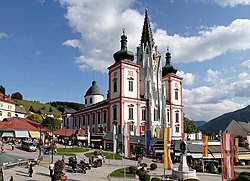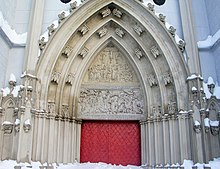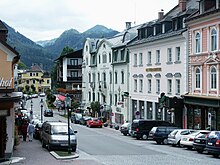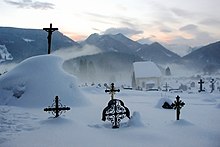Mariazell
This article needs additional citations for verification. (June 2014) |
Mariazell
Mariazöö | ||
|---|---|---|
 | ||
|
Postal code 8630 | ||
| Area code | 03882 | |
| Vehicle registration | BM | |
| Website | www.stadt-mariazell.at | |
Mariazell (
It is a site of pilgrimage for
History
There is no trace of large or enclosed settlements in the area of modern Mariazell dating from pre-Christian times or the first century AD. The large number of
By AD 16 the Romans were using the salt roads of Halltal and the Traisental. According to some accounts, there also was a Roman road going to Neuhaus.
In 600 the Slavs, under the leadership of the Avars, took control of the land and settled in the mountain region and began farming. The expansion of these peoples also accounts for the existence of some of the town and mountain names today.
In 1025,
In 1157, Monk Magnus came into the Zellertal with a lime-tree wood statue of the Virgin Mary and founded the first chapel there, around which the town later grew. The town's name derived from the description "Mary in the cell", i.e. in the monk's chapel.
In 1344, Mariazell was elevated to the status of market town.
Between 1340 and 1380, the church was rebuilt in the
In 1420, the Turks of the Ottoman Empire invaded Mariazell for the first time and burned the church and the town.
In 1474, another fire devastated the town.
In 1532, the Turks returned to Mariazell and set more houses on fire.


1644: The "baroque-ization" of the church is begun by Abbot Benedikt Pierin, and the commission is given to Master Builder Sciassia. After his death the construction was continued by various other workers before being completed in 1780.
1679: Emperor Leopold I visited the shrine, and a valet in his entourage brought the plague to Mariazell. Fear and terror took hold as 156 townspeople fell victim to the disease.
1683: Fears arising from yet another Ottoman invasion caused the holy statue as well as the treasury images to be sent to St. Lambrecht, from which they were returned later that year.
1742: The Empress granted Abbot Eugen Inzaghi the privileges of an Archabbot over Gollrad and Aschbach, as well as over the Mariazell cast iron works.
In 1782, Joseph Haydn wrote the Mariazell Mass, for pilgrims to the Basilica in Mariazell. The mass was commissioned at the request of the pilgrims, through a military officer.[3]
In 1786, Emperor Joseph II dissolves the Monastery of St. Lambrecht, from which Mariazell was serviced, in the course of his cloister abolishments. The pilgrimages are hampered and later completely forbidden.
In 1798, a conflagration destroyed the town; the area of Wiener Straße was especially hard hit.
1805: The Battle of Mariazell is fought in the area during the War of the Third Coalition as the French invade Austria.
1809: Faced with a French advance in the War of the Fifth Coalition, church treasures are brought to Temesvár in Hungary for security. A few weeks later, the French arrive at Mariazell. Combat operations, requisition, and crop failures lead in these years to a massive decrease in population.
1816: A great famine takes place.
1818: Archduke Johann buys the Brandhof.
1827: Mariazell's largest fire, which incinerates almost the entire town, and leaves the church with great fire damage, occurs on
1828 - 1832: The town is rebuilt with great hardship and suffering.
1892: The idle boring machine of the cast-iron factory is converted to a power plant; the following year, Mariazell gets electric power for the first time.
1896: The building of the first public water service begins.
1898: The Mariazell cast iron factory is shut down.
1907: The
1911: The Mariazellerbahn becomes electric.


1924: The first festival in the newly built festival theatre is begun.
1925: The festivals reach their high point. In the following years, financial decline brings them to an end.
1928: A gondola to the Bürger Alps becomes the first funicular to be built in Austria. That same year, the water system in expanded around the "Student-Quelle".
1945: The Red Army enters Mariazell and takes accommodations for 5,000 men.
1948: Mariazell is elevated to the status of a city.
1955 - 1957: A general restoration of the church takes place. During these years, a by-pass and a new post office are built.
1966: The fathers of the Kremsmünster Monastery separate from the fathers of the Schottenstift, who had been in charge of the ecclesiastical leadership of Mariazell since 1949. In the following years, extensive restoration work is done on the church, the priory, and the nearby chapel. The new rosary path is also built during this time.
1976: Mariazell gains an indoor swimming pool and, a few years later, the enlargement of its Hauptschule.
1983: Pope
1990: Thanksgiving and freedom pilgrimages from the former Eastern Bloc states bring 25,000 participants to Mariazell.
1992: The
2004: Central European Catholic Day - a pilgrimage of the people to Mariazell brings over 100,000 visitors.
2007: Pope Benedict XVI visits Mariazell to celebrate the 850th anniversary of the foundation of the Shrine of Mariazell.
Politics
Municipal council
The municipal council has 21 members; the 2020 elections returned:
City council
The city council consists of the following members:
- Walter Schweighofer (ÖVP) – Mayor
- Helmut Schweiger (ÖVP) - Vice-Mayor
- Johann Kleinhofer (SPÖ) - Vice-Mayor
- Jürgen Ebner (ÖVP) - Financial Officer
- Fabian Fluch (SPÖ) - City Councillor
Coat of arms
The city coat of arms shows a black shield with a stylized depiction of the Gothic archway of the Mariazell Basilica in gold. Before it stands the gold-crowned Mariazeller Madonna with a similarly crowned Christ Child on her right arm. The Madonna wears a blue cloak and is wrapped in a silver-white robe, as is the Christ Child. The chests of both figures are adorned with a small cross.
Culture and landmarks

Most notable about the
Transport
Mariazell lies on the highway B 20, which goes from
Mariazell is also the southern endpoint of the
Mariazell Airport is a private use airport that is located 2 kilometres (1 mi) north-northwest of Mariazell.
International relations
Twin towns – Sister cities
Mariazell is
References
- This article incorporates text from a publication now in the public domain: Chisholm, Hugh, ed. (1911). "Mariazell". Encyclopædia Britannica. Vol. 17 (11th ed.). Cambridge University Press. p. 709.
- Notes
- ^ "Dauersiedlungsraum der Gemeinden Politischen Bezirke und Bundesländer - Gebietsstand 1.1.2018". Statistics Austria. Retrieved 10 March 2019.
- ^ "Einwohnerzahl 1.1.2018 nach Gemeinden mit Status, Gebietsstand 1.1.2018". Statistics Austria. Retrieved 9 March 2019.
- ^ "HAYDN, J.: Masses (Complete) (Trinity Choir, Rebel Baroque Orchestra, Burdick, Glover) (8 CD Box set)".
- ^ Bačić, Tomay (April 2015). "Mariazellerbahn: Modernised but still charming". Today's Railways Europe. No. 232. Platform 5 Publishing Ltd. pp. 34–38.
External links
- Central European Catholic Day (Mitteleuropäischer Katholikentag) (in German)
- Bazillika Mariazell (in German)
- Mariazell und das Mariazeller Land (in German)
